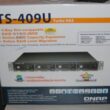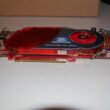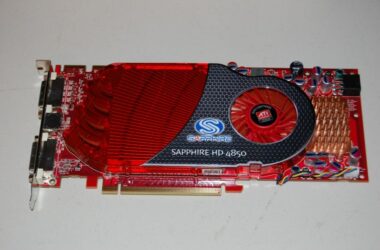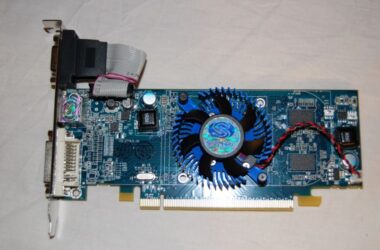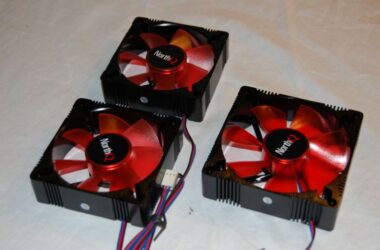Introduction
I previously looked at Palit’s GeForce 9600 GSO Sonic videocard, an nVidia-based card. The GeForce 9600 GSO featured many improvements over the base 9600 GSO, as Palit incorporated improved power phases, a more powerful cooling solution, as well as coming factory overclocked.
Palit recently sent their new Radeon HD4850 videocard our way, and while it lacks some of the improvements I saw in the GeForce 9600 GSO Sonic, I’ll look at a newer firmware version than the Sapphire Radeon HD4850 BIOSLEVEL.com previously looked at.
As demonstrated in the review of Sapphire’s Radeon HD4850, the Radeon HD4850 has some serious advantages against nVidia’s current line-up, but it also had it’s show of shortcomings. In this review, I’ll look at performance and Linux compatibility, as well as performance in Windows.
Packaging & Appearance
Palit’s Radeon HD4850 came to us in packaging very similar to that of Palit’s GeForce 9600 GSO Sonic, with the exception of some text and color changes. The green was replaced with red, a color usually associated with ATI’s Radeon brand. The front of the box once again features Palit’s avatar, Frobo, the robotic frog. It also lists the model number and some of the major features of the card.
The rear of the box features the HD4850’s features in about a million different languages.
Inside, the contents are protected with a cardboard covering. Putting it out reveals the installation CD and some of the accessories: a CrossFire bridge, component out cables, and a DVI to VGA adapter. The card is held in the cardboard packaging itself.
Once removed from the cardboard, the Radeon HD4850 is protected by anti-static bubble wrap. Once removed, the card doesn’t look much differen that the card I received from Palit. This is because the initial make of the Radeon HD4850 are all reference designs, and much like Sapphire, Palit hasn’t yet been able to put their own spin on the card.
Built with a red PCB to go with ATI’s color branding, Palit added their own graphical enchancements to the GPU cooler and fan to make it their own. The card is similar in length compared to the GeForce 8800GTS and Radeon HD3870.
A single six-pin PCI-Express power connector is all that’s required to power the Palit Radeon HD4850.
Features & Specifications
The Radeon HD4850 is a brand-new series of cards, featuring a new GPU and 512MB of GDDR3 memory. That said, it can only be assumed that aside from improved performance, the Radeon HD4850 also brings new features to the table as well.
Features
- Dynamic geometry acceleration
- Game physics processing capability
- ATI PowerPlay technology
- ATI CrossFireX Multi-GPU Technology
- ATI Avivo HD video and display technology
- Built for Microsoft® Windows Vista
- Full Microsoft® DirectX® 10.1 Shader Model 4.1 support
While benefiting from a new 55nm manufacturing process, the Radeon HD4850 has several advantages over the HD3870 such as 7.1 audio over HDMI, and improved physics processing. Let’s look at the specifications of the unit to see the power providing these features.
Specifications
- Part Number: AE/48500+T352
- Bus interface: PCI Express 2.0
- 2x Dual-link DVI outputs support 2560×1600 resolution displays
- Memory Support: 512MB GDDR3
- Memory Interface: 256 bit
- Memory Clock: 1986MHz (933 x 2)
- Core Clock: 625 MHz
- HDCP capable
- HDMI function via dongle
- Power Supply Unit Requirement:
500 Watt or greater power supply with a 75W 6-pin PCI-Express power connectors recommended (600 Watt and two 6-pin connectors for ATI CrossFireX technology in dual mode)
Surprisingly, the Radeon HD4850 is clocked slightly slower than the Radeon HD3870, but has roughly 50% more transistors. I hope benchmarks will reveal that the new manufacturing process has given the card a large advantage over the previous generation of cards and such a difference in clock speeds will mean nothing.
Installation
As with most videocards, installation was a snap. Press the card in, and screw in the PCI bracket to secure. Don’t forget the 6-pin PCI-Express power connection.
Unlike the Palit GeForce 9600 GSO, the Palit HD4850 doesn’t block my SATA ports.
With the physical installation complete, all that was left to do was install the latest Catalyst 8.6 driver in both Linux and Windows. Both versions of the drive can be found on AMD’s website
Benchmark Setup
I’ll be using the same system I’ve used in previous videocard reviews, and the system will be running both Windows Vista Business 64-bit with Service Pack 1 and Gentoo Linux 2008.0 64-bit. I’ll look at some of the latest games in Windows, and look at a few similar benchmarks in Linux including results from the Phoronix Test Suite.
| Component | Part | |
|---|---|---|
| Processor | AMD Phenom 9500 | |
| Motherboard | Sapphire PI-AM2RS780G 780G | |
| RAM | 2GB DDR2 PC2-8500 Reaper HPC CrossFire Certified | |
| Video Card | Palit Radeon HD4850 | |
| Chassis | X-Qpack | |
| CPU Cooling |
Scythe Katana II | |
| Hard Drive | Excelstor 250GB SATA2 | |
| Power Supply | Antec SmartPower 500W Modular PSU | |
| Display | 1280×1024 | |
| Operating System | Windows Vista Business SP1 64-bit / Gentoo 2008.0 64-bit | |
That said, I’ll be able to compare the Radeon HD4850 directly against videocards I’ve reviewed previously. Let’s get started with the Windows benchmarks. I’ll be looking at performance in Cinebench, 3dMark06 and Vantage, Unreal Tournament 2004, Unreal Tournament 3, Crysis, Quake 4, and Half-Life 2.
Windows Benchmarks
I started off the benchmarking process with some of our typical gaming benchmarks. Once again, I’m testing with Windows Vista 64-bit with Service Pack 1. As we’ve seen with previous reviews, Windows Vista really hits hard when it comes to gaming performance. The 32-bit version shows decrease in FPS in most games, but the 64-bit version shows an even greater decrease. Many of these cards we test with are capable of much higher framerates, but, well… it’s 64-bit Vista.
I have some animosity towards Vista, having lost my workstation’s hard drive recently. In the future, BIOSLEVEL.com may try to deviate away from Windows benchmarks all together. This will both increase the focus of our site, as well as giving us more time to work with the products in Linux while under deadlines.
Unreal Tournament 2004
Since a Linux port of Unreal Tournament 3 has yet to be released for Linux, I use Unreal Tournament 2004 as a benchmark to compare Linux and Windows performance from videocards and processors. Although an older game, the framerate is still a good determining factor of how good a videocard is. I tested Unreal Tournament 2004 with everything set the maximum settings, at our default resolution, 1280×1024. I’m also using the OpenGL rendering engine, as that is the only available engine in Linux.
Unreal Tournament 3
Despite there not yet being a Linux port, Unreal Tournament 3 is one of the latest PC games out and uses the powerful Unreal Engine 3. Games such as Bioshock, Turok, and others also use this engine, making Unreal Tournament 3 a great benchmark to give an idea how these games will perform as well.
Crysis
Is one of the latest, cutting-edge games. Additionally, Crysis has a 64-bit port whereas Unreal Tournament 3 does not. I found gameplay to be mostly unplayable with anything higher than the default medium settings. I’m attributing this to an issue with the 64-bit version of Vista. Microsoft’s 64-bit operating system just doesn’t seem ready for the prime time yet.
Windows Benchmarks, Continued
Quake 4
Like Unreal Tournament 2004, Quake 4 is a slightly older engine. It remains relevant in that many games still use the engine such as Doom 3 and Quake Wars, and it also has a Linux port. Quake 4 was benchmarked using the highest settings available.
Half-Life 2
Half-Life 2 remains one of the most popular game engines due to the various “Source” games Valve has released, such as Counter-Strike: Source. Additionally, many incremental updates have been added to the game with the episode-style updates Valve released for the game. Half-Life 2 was benchmarked with both Episodes installed, and all settings set to the maximum available.
3dMark06
The benchmark is about two years old now, but still an effective way to look at a video card’s performance.
3dMark Vantage
Futuremark’s latest gaming benchmark is the pinnacle of gaming benchmarks and technology, as it may very well bring any setup to its very knees. Through a series of DirectX 10.1, Physics, and CPU tests, 3dMark Vantage measures every ounce of performance that a system is capable of, in every area the latest games utilize.
Windows Benchmarks, Continued
Maxon Cinebench
I’ve decided to add a new Windows benchmark to the mix, Maxon Cinebench. Cinebench is based on Maxon’s Cinema 4D animation software, which is used extensively by studios and production houses worldwide for 3D content creation. On top of this, Maxon has a 64-bit version of Cinebench, perfect for my purposes.
Conclusion on Windows Benchmarks
Once again, I see a Radeon HD4850 card blow past the competition. Of course, this Palit model still has Sapphire’s Radeon HD4850 to compete with. Despite the Radeon HD4850 not being AMD’s top offering, there is still plenty of power behind this card.
From older games such as Quake 4 and Unreal Tournament 2004, to the latest games such as Crysis and Unreal Tournament 3, the Radeon HD4850 offers numerous improvements. As ATI’s flagship series, the Radeon HD48xx series holds its own against ATI’s previous families, as well as against nVidia’s offerings.
All the games and benchmarks ran as smoothly as I could imagine under Windows Vista 64-bit, but I imagine performance would have been better in a 32-bit environment. Let’s move on to see how well the card performs in Linux.
Linux Benchmarks
As mentioned in previous reviews, I’m using Gentoo Linux 2008, mostly because I’m more comfortable in a Gentoo environment, but also because the software is compiled specifically to your machine’s specifications (or the best available for the machine, anyways). The operating system has been compiled as 64-bit, so it’ll be interesting to see how some of these benchmarks compare to their Windows counterparts.
For Linux, I’ll be look at Unreal Tournament 2004, Quake 4, glxgears, and Nexuiz. Nexuiz will be tested using the Phoronix Test Suite. The other games will be tested with the same settings as in Windows.
Unreal Tournament 2004
With the 64-bit version of UT2004 installed in Linux as well, I set the settings to the maximum and ran a botmatch on DM-Rankin.
Quake 4
Much like the Windows version, I had everything set to the maximum.
glxgears
glxgears is a simple benchmark included on most distros by default. Although not always a fantastic judge of performance, glxgears can give you a ballpark estimate on how well your video card will perform.
Nexuiz
Nexuiz is a popular open source first person shooter based on a modified (and very advanced) Quake 1 engine. Phoronix recently release a test suite, consisting of some of the benchmarks they commonly use when benchmarking hardware, and it’s all automated through PHP scripts. I opted to run Nexuiz through their benchmark system to standardize the results.

Conclusion on Linux Benchmarks
I didn’t entirely expect the Radeon HD4850 to play completely on par with the Radeon HD3870 in Linux. ATI has not released new Linux drivers since my review of Sapphire’s Radeon HD4850, so there is no performance gains to be seen in Linux.
It’s kind of disappointing to see the performance I saw in Windows diminish so much in Linux. Although AMD claims the Linux driver simply hasn’t been optimized for the Radeon HD4850, how long will it be before we catch glimpse of these optimizations?
Regardless of these issues, the Radeon HD4850 did fall where I expected it to. Despite the performance gap in Windows against the nVidia family of cards, I did expect the Radeon HD4850 to fall behind these cards in Linux. As I’ve said many times before: nVidia’s Linux driver, while not perfect, is still superior to AMD’s.
Temperature & Noise
Since the X-Qpack is a small-form factor case, space is tight and wires are fairly abundant. The power supply is directly above videocard, and there’s a single 120mm fan on the rear of the case, in the corner opposite the videocard. Suffice to say, there isn’t a lot of cooling options. Although the 9600 GSO maintained respectable temperatures, I think a lot of it had to do with the dual-slot cooler.
Something to consider with Palit’s Radeon HD4850 is that it was sent to me with a final firmware, whereas I had to flash Sapphire’s HD4850 with update firmware.
Palit’s Radeon HD4850 runs idle at 62°C, and heats up to a burning 70°C under full load. This is much more respectable than Sapphire’s card, but I have a feeling much of this has to do with the card’s firmware.
While idle, the card is near silent. Every so often, the fan spinning up can be heard, but the card remains reasonably quiet unless under a heavy load.
Final Thoughts & Conclusion
While the Palit’s Radeon HD4850 is nearly identical to Sapphire’s, I did come across a few differences aside from the different colored stickers. Those differences are the heat output and fan noise levels. My assumption is that the Palit’s Radeon HD4850 shipped with a newer BIOS than Sapphire’s, keeping the card quieter and cooler.
Palit’s Radeon HD4850 is an excellent choice for enthusiasts and gamers alike, and the card is also quite stable in Linux. Obviously I’d like to see a little more performance from the card in Linux, but I’m told that a future driver release will show some solid improvements in that area. Readers can be assured that BIOSLEVEL.com will stay on top of this.
Overall, Palit has a great product on their hands. I’d like to see them expand their ATI-branded offerings with a few overclocked models, much like they do for their nVidia-branded cards.
Pros
- PCI-Express 2.0 Support
- 512MB GDDR3
- CrossFireX Supports up to four GPUs
- Runs cool and quiet
- HDCP / HDMI compliant for watching HD movies on HD displays
- Only takes up one slot
Cons
- ATI Linux driver still needs work














